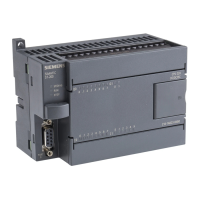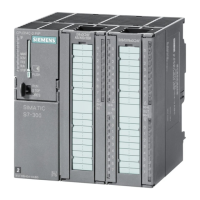Glossary
S7-300 Automation System Module data
Glossary-8 Manual, 08/2006, A5E00105505-04
Resolution
Number of bits representing the value of analog modules in binary format. The resolution is
module-specific. It is also determined by the → integration time of analog input modules. The
precision of the measured value resolution increases with the length of the integration time.
The maximum resolution is 16 bits + sign.
Restart
At its restart (initiated by setting the mode selector switch from STOP to RUN, or after
POWER ON), the CPU first executes restart OB 100, and then continues with cyclic program
execution (OB1.)
During its restart, the CPU reads the → Process image of inputs (PIO), and then executes
the STEP 7 user program, starting at the first statement in OB1.
Retentivity
Data areas in data blocks (DBs), timers, counters and flags are considered retentive if their
content is not lost as a result of restart or power off.
Scaling
STEP 7 parameter for the SM 338; POS-INPUT position detection module. Scaling right-
aligns the → Absolute encoder value in the address space; irrelevant places are discarded.
Segment
→ Bus segment
SFC
→ System Function
Signal module
Signal modules (SMs) form the interface between the process and the automation system.
These are available as digital and analog input/output and IO modules.
Smoothing
STEP 7 parameter for analog input modules. The measured values are smoothed by digital
filtering. Users can select module-specific filter properties, i.e. none, low, medium or high.
The time constant of the digital filter increases in proportion to the degree of smoothing.
STARTUP
STARTUP mode initiates the transition from STOP to RUN mode. STARTUP can be
triggered by setting the → mode selector, by power on, or by an operator action on the
programming device. S7-300 performs a → restart.
